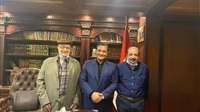Iran accused of using unlawful force in water protest crackdown

Iran is using unlawful and excessive force in a crackdown
against protests over water shortages in its oil-rich but arid southwestern
Khuzestan province, according to international rights groups.
Amnesty International said it had confirmed the deaths of
at least eight protesters and bystanders, including a teenage boy, after the
authorities used live ammunition to quell the protests.
Iranian media and officials have said at least three
people have been killed, including a police officer and a protester, accusing
“opportunists” and “rioters” of shooting at protesters and security forces.
“Iran’s security forces have deployed unlawful force,
including by firing live ammunition and birdshot, to crush mostly peaceful
protests,” Amnesty International said. Analysis of video footage from the
protests and witness accounts “indicate security forces used deadly automatic
weapons, shotguns with inherently indiscriminate ammunition, and teargas”, it
said.
Human Rights Watch, meanwhile, said in a separate
statement that Iranian authorities appeared to have used excessive force
against demonstrators and the government should “transparently investigate” the
reported deaths. “Iranian authorities have a very troubling record of
responding with bullets to protesters frustrated with mounting economic
difficulties and deteriorating living conditions,” its Iran researcher, Tara
Sepehri Far, said.
Rights groups have previously accused Iran of launching a
ferocious crackdown in 2019 against nationwide protests over fuel price rises
that, according to Amnesty, killed at least 304 people.
“Iran’s authorities have a harrowing track record of
using unlawful lethal force. The events unfolding in Khuzestan have chilling
echoes of November 2019,” said Diana Eltahawy, Amnesty’s deputy director for
the Middle East and North Africa.
Amnesty said a teenage boy, Hadi Bahmani, had been killed
in the town of Izeh.
Iranian authorities have blamed the unrest on rioters.
Amnesty said the Fars news agency had published interviews with relatives of
two of the men killed, distancing themselves from their actions. However, the
rights group cited a source as saying that one of the families had been visited
by plain clothes agents who “coerced them into reciting a pre-prepared script
on camera”.
Human Rights Watch said there had also been reports of
internet shutdowns in the area, and that “over the past three years,
authorities have frequently restricted access to information during protests”.
Khuzestan is Iran’s main oil-producing region, but has
been struggling with an intense drought since March. The province is home to a
large Arab minority, and its people complain regularly of being marginalised by
the authorities.
Iran’s supreme leader, Ayatollah Ali Khamenei, said on
Friday he understood the protesters’ anger over the drought in the country’s
south-west. The remark, reported by state television, was his first direct
comment on the protests since they began a week ago.
“People showed their discontent, but we cannot have any
complaint since the issue of water in the hot climate of Khuzestan is not a
minor issue,” Khamenei was quoted as saying.
He accused Iran’s enemies of trying to exploit the
situation, and warned: “The enemy will try to use any tool against the
revolution, the nation and the people’s interests, so we must be careful not to
give him any pretext.”
He praised the people of the region for their loyalty and
efforts during the war against Iraq in the 1980s, adding that “the people
should not face problems” any more.
Iran’s president, Hassan Rouhani, said on Thursday that
citizens had the right to protest.







